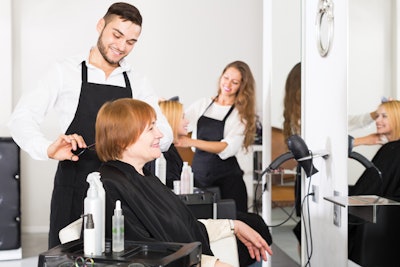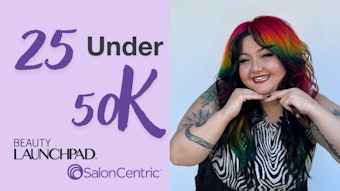
Repetitive arm movements, holding heavy tools, standing for long periods of time—these are the parts of the job you can’t dodge as a stylist, and unfortunately, they are the causes of various physical ailments. “Due to the nature of their work, hairdressers are at a high risk of developing pain in a few key areas,” says Rachel Holt, doctor of physical therapy. “Because the job involves such long periods of standing and looking down, low back and neck pain are very common problems. Second, and more obvious, are overuse injuries of the elbows, wrists and hands.” Here, she shares tips for managing pain to boost the quality of your daily life.
-
Improve Your Posture - An easy way to avoid significantly increasing stress to the lower back is to stand behind the chair with a staggered stance, positioning one foot in front of the other. Additionally, you can alternate which leg is in front. “This helps disperse force through the spine and actually prevents hyperextension or ‘locking out’ the knees,” remarks Holt.
-
Choose Good Shoes - “The one thing I always notice when I enter a hair salon is how stylish everyone is,” Holt points out. “But anytime I see someone who appears to be suffering from back pain, nine times out of 10, they’re wearing shoes that are incredibly unsupportive.” To alleviate pain while salvaging your favorite footwear, buy a pair of cushioned insoles, which offer more support to the feet, knees and back.
-
Position Clients Properly - To avoid neck and shoulder pain, make sure that your client is at the correct level for you to perform the job without having to look down for extended periods. “Keeping your client’s head level with your heart is crucial to avoid excessive strain to the neck, or the ever so common forward head posture,” explains Holt.
-
Protect Your Hands - Investing in tools that are more ergonomically friendly will make a world of difference on the strain placed on your hands. “Sam Villa created an amazing line of offset shears that can significantly work to reduce strain to the wrist by allowing it to stay in a more neutral position,” Holt points out. “Swivel shears can also greatly decrease the stress placed across the thumb.”
-
Stretch Often - “Wrist and elbow stretches can be done either throughout or immediately following your workday to assist relieving all the pressure built up in your hands, wrists and elbows,” says Holt. Extend one arm forward at shoulder height with fingers pointing downward. With your free hand, gently grasp fingers and pull them back toward your body. Hold for 30 to 60 seconds; switch hands. For an additional stretch, extend one arm out with your palm facing outward; pull fingers back with your free hand and hold for 30 to 60 seconds, then switch. “Allow at least 30 seconds to rest in-between,” she adds. “A stretch may be felt anywhere from the fingers up through the forearm, but shouldn’t be pushed to the point of pain.”
[Image: Getty Images]











